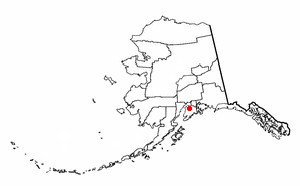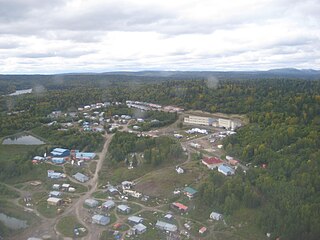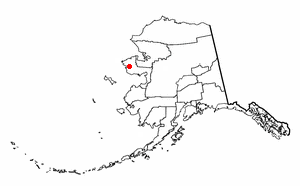
Naknek is a census-designated place located in and the borough seat of Bristol Bay Borough in the U.S. state of Alaska. As of the 2020 census, the population of the CDP was 470, down from 544 in 2010.

Sterling is a census-designated place (CDP) in Kenai Peninsula Borough, Alaska, United States. At the 2020 census the population was 5,918, up from 5,617 in 2010. Sterling is the tenth-most populated CDP in Alaska.
St. Michael, historically referred to as Saint Michael, is a city in Nome Census Area, Alaska. The population was 401 at the 2010 census, up from 368 in 2000.

Kobuk is a city in Northwest Arctic Borough, Alaska, United States. At the 2010 census the population was 151, up from 109 in 2000.

Chenega is a census-designated place (CDP) on Evans Island in the Chugach Census Area in the U.S. state of Alaska. Located in Prince William Sound, the CDP consists of the Chugach Alutiiq village of Chenega Bay, which was established only after the Good Friday earthquake destroyed the original community on Chenega Island to the north. As of the 2020 census, the population of the CDP was 59, largely Alaska Natives; as of 2021, the population of Chenega is estimated at 49. Chenega Bay is in the Chugach School District and has one school, Chenega Bay Community School, serving approximately 16 students from preschool through high school.

Russian Mission is a city in Kusilvak Census Area, Alaska. It was the location of a fur trading post of the Russian-American Company in 1842. After the sale of Russian-American possessions to the United States in 1867, it was officially named Russian Mission in the early 1900s. The sale of alcohol is prohibited. At the 2020 census the population was 421, up from 312 in 2010.

Alatna is a census-designated place (CDP) in the Yukon-Koyukuk Census Area of the Unorganized Borough in the U.S. state of Alaska. The population was 35 at the 2020 census.

Arctic Village is an unincorporated Native American village and a census-designated place (CDP) in Yukon-Koyukuk Census Area, Alaska, United States. As of the 2010 census, the population of the CDP was 152. This was unchanged from 2000. The village is located in the large Gwitch'in speaking region of Alaska, and the local dialect is known as Di'haii Gwitch'in or shahanh. As of 1999, over 95% of the community speaks and understands the language. As of 2019, the second village chief was against oil drilling because of the impact on caribou.

Bettles is a city in Yukon-Koyukuk Census Area, Alaska, United States. It is near Gates of the Arctic National Park and Preserve. The population was 23 at the 2020 census, up from 12 in 2010. It is the second smallest incorporated city in the state.

Katalla is a ghost town in the Valdez-Cordova Census Area in the U.S. state of Alaska, 76 km (47 mi) southeast of Cordova. The name of this town was sometimes spelled Catalla. It is now abandoned.
Telida is an unincorporated community located in the Yukon-Koyukuk Census Area in the U.S. state of Alaska. At the 2010 census the population was 3, unchanged from 2000.
Council is an abandoned townsite in the Nome Census Area in the U.S. state of Alaska. It has a population of zero as of the 2000 and 2010 U.S. Censuses.

Mary's Igloo is an abandoned village located in the Nome Census Area of the Unorganized Borough in the U.S. state of Alaska, now used as a fish camp. Many former residents and their descendants currently live in nearby Teller or the next largest community, Nome.
Georgetown is an unincorporated Alaska Native village located in the Bethel Census Area of the U.S. state of Alaska. The population as of the 2010 census was 2, down from 3 in 2000.
Ekuk is a small unincorporated community in the Dillingham Census Area in the U.S. state of Alaska. As of both the 2000 and 2010 U.S. Censuses, it had a population of 2. It is classified by the U.S. Census as an Alaska Native Village Statistical Area (ANVSA). Until 2002 it was the site of a large fish processing operation owned by Wards Cove Packing Company. Currently, it is inhabited mainly by seasonal fishing families who set gillnet in the nearby waters of the Nushagak Bay for mid-summer runs of sockeye salmon, early season runs of king salmon and late season runs of silver salmon.
Napaimute is an unincorporated Alaska Native village located in the Bethel Census Area of the U.S. state of Alaska. It is classified as an Alaskan Native Village Statistical Area. As of the 2010 U.S. Census, it has a population of 2. This is up from a population of zero in 2000.
Alexander is an unincorporated community in Matanuska-Susitna Borough, Alaska, United States. An Alaska Native community with an Alaska Native Village Corporation, it lies on the Susitna River delta, near the mouth of Alexander Creek, and 27 miles (43 km) northwest of Anchorage, Alaska Cook Inlet Low. It is located within the boundaries of Susitna CDP.
Nabesna is a census-designated place and unincorporated community in northern Copper River Census Area, Alaska, United States, in the northern part of the Wrangell-St. Elias National Park and Preserve. It lies along the Nabesna Road, a gravel road that connects it to the Tok Cut-Off at Slana. Its elevation is 2,979 feet (908 m). Founded by and named for the Nabesna Mining Company, the community received a post office in 1909. Located at the base of White Mountain in the Wrangell Mountains, it lies west of the Nabesna River. According to the 2020 census, there were two people residing at this location.

Pauloff Harbor is an unincorporated community with no year-round population on the west side of Pavlov Harbor on the northern coast of Sanak Island, 50 miles (80 km) southeast of False Pass, in the Aleutians East Borough of the U.S. state of Alaska. The primary means of transportation is boats and float planes from False Pass or King Cove. While a post office was established in 1949, the village has no permanent population at present or public facilities, although a village corporation operates from a post office box in Sand Point, where most of the corporation shareholders live.

Circle Hot Springs is a hot spring and an unincorporated community in the Yukon-Koyukuk Census Area of Alaska in the United States. The community is home to a hot spring and is the site of the now-closed Arctic Circle Hot Springs resort. The hot spring can be accessed either by automobile via the Steese Highway or by plane via the small-scale Circle Hot Springs Airport. The area surrounding the hot spring is rich in mining history and retains a certain degree of mystery and folklore.












